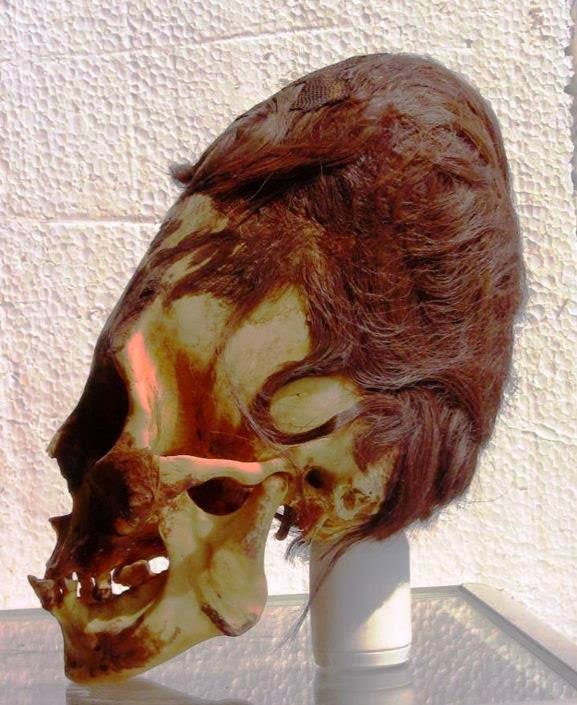Are the Paracas Skulls Sasquatch?
Posted by: Kirk Sigurdson on February 12th, 2014

DNA tests have recently been conducted on a very unusual skull, which was discovered in Paracas, Peru. According to Brien Foerster, it has “mtDNA with mutations unknown in any human, primate, or animal so far known. The cranial volume is up to 25 percent larger and 60 percent heavier than human skulls… [and] it contains only one parietal plate, rather than two.”
The skull is one of three hundred that were discovered on a dig in 1928. Julio Tello, a Peruvian archaeologist, supervised the dig, which took place on a desert peninsula of the South Coast of Peru. The region was once a significant part of the Incan empire.
Brien Foerster holds a Bachelor of Science degree from the University of Victoria, Canada. Since he did not earn a PhD from any university, his credentials are in question. Foerster runs guided tours in Peru, and has appeared four times on Ancient Aliens, a television program on the History Channel.
It is not surprising that the first public confirmation of DNA tests on the skulls, which are elongated to a remarkable degree, would be conducted by an amateur archaeologist. Peru is one area of the planet that has ruined quite a few careers in archaeology and anthropology. Why? Because the current power structure of our planet does not want to disclose things like non-human skulls, giant skeletons, and evidence of civilizations that run counter to the prevailing archaeological “record.” Modern DNA tests were perfected in the 1980’s. One has to wonder why a test was not conducted on Paracas skulls before 2014, or, if tests were conducted, why the results were not made public.
One thing is certain: The Paracas skulls are highly unusual and worthy of DNA testing. Considering how heavy and how large the skulls are, it would be interesting to hear whether any skeletons were found with them. Out of three hundred skulls, it’s hard to believe that not even one (assumedly giant) skeleton was found–if not in 1928, then in the decades that followed Tello’s discovery.
For more information on the Paracas skulls, go to: DNA Tests Reveal South American Elongated Skulls NOT Human
About Kirk Sigurdson
Kirk Edward Sigurdson attended New York University, where he earned a Master's degree in English literature. His master's thesis entitled "A Gothic Approach to HP Lovecraft's Sense of Outsideness" was published in Lovecraft Studies Journal.
After writing three novels while living in Manhattan's East Village, Sigurdson returned to his native state of Oregon. It wasn’t long before he began work on a fresh new novel that drew upon his knowledge of the sasquatch phenomenon.
As research, he ventured dozens of times into sasquatch "hot spots" for overnighters, often with friends who shared some very unique experiences. He also drew upon childhood exposure to sasquatch calls and knocking that occurred during family camping trips to Horseshoe Lake in the Cascades mountains.
Kirk Sigurdson is currently a Professor of Writing and English literature at Portland Community College.










It’s a typical shaped skull of the culture and period. Nothing to get excited about folks. I’ll let our friend Sharon Hill explain since she does such a great job of it.
As an archaeologist, I’ll add that a common way to spot someone trying to hid shoddy reasoning and evidence with things like this is to blame the “Power structure” that is supposedly hiding the “REAL” evidence. That’s a big red flag that the person you are dealing with has serious credibility issues. The reason these guys get flak from actual experts is that their work is crap and deceitful in nature.
I would like to see the results of the DNA tests over the discussion of them. Looks as if there may have meant to be a link in the last sentence? Searching for that phrase does not seem to lead to any published article.
@semillama
“It’s a typical shaped skull of the culture and period.”
I don’t see any explanation of this by Sharon Hill or Ben Radford. I just see a lot of bashing, which I don’t find constructive. Maybe you can just post up the facts here about those period skulls. Especially ones that have one parietal plate instead of two.
Read down into the comments and you’ll find a nice summation of research into cultural cranial deformation, presented by the poster spookyparadigm. Fusion of the sagittal suture will mask the suture break between the two parietal plates, giving the illusion there is only one.
again, some basic research into the matter using sources by people who have actually devoted their academic careers to studying South American cultures would reveal that this type of cranial deformation is not surprising.
Of course, one could simply look at the facial structure alone of the skull and see that it is nothing but Homo sapiens.
Hi semillama,
Still no explanation of the increased volume and weight exhibited… if it’s so basic, then you should be able to easily explain to us how intentional cranial deformation increases skull volume.
Coming late to the party, but I’ll gladly offer a comment or two in support of semillama’s sound argument.
Cranial deformation is a common cultural practice among humans of many different regions and time periods. Even modern Europe is not immune from the custom, as head binding was still in practice in France as late as the 1830’s which equates to only 6 or 7 lifespans from where we are now.
While South America could have arrived at the practice on their own, as many separate cultures have, there is much evidence to support that the practice was picked up from north African traders who were held in very high regard. These early visitors have left their mark on many cultures across South America, including the African-featured elephant-adorned Olmec heads of Chihuahua and the Egyptian style boats of Lake Titicaca.
It is not a great leap of faith to think that men from north Africa, where cranial deformation among rulers was seen as physical proof of their godhood, would make a big impression on the minds of Peruvians (no pun intended) who also saw their leaders as gods or liaisons of the gods.
Cranial deformation results in the physical characteristics that these skulls display. The binding of the skull during growth causes a denser skull with fused plates and an elongated cranial cavity. In other words, we know what cranial deformation looks like.
There are plenty of mysteries in this world of ours, this is not one of them. Don’t be petulant just because reality sometimes bursts your bubble- just learn to move on to the next mystery and learn to enjoy the ride.
Cheers.
Here are two links to sites with nice summaries:
Bones dont lie – Not Aliens, Just Humans with Modified Crania?
Artificial Cranial Deformation
Hey hoodoo,
You gave a rather long winded reply but still failed to answer the orginal question of how intentional cranial deformation increases volume. You can’t, because it doesn’t… this very basic info is readily available from Wiki:
“There is no statistically significant difference in cranial capacity between artificially deformed skulls and normal skulls in Peruvian samples.”
Exploring artificial cranial deformation using elliptic Fourier analysis of Procrustes aligned outlines.
Friess M, Baylac M.
Hey hoodoo,
I actually read your 1st link (your 2nd link is in Indonesian) and didn’t see where it mentioned cranial capacity or volume at all… maybe I missed it, can you point it out for us?
Here’s a 2nd study which addresses volume in intentional canial deformation:
Shape and volume of craniofacial cavities in intentional skull deformations.
Khonsari RH, Friess M, Nysjö J, Odri G, Malmberg F, Nyström I, Messo E, Hirsch JM, Cabanis EA, Kunzelmann KH, Salagnac JM, Corre P, Ohazama A, Sharpe PT, Charlier P, Olszewski R.
From the abstract:
Our findings confirm that volumes of the cranial cavities are not affected by ICDs but that the shapes of the orbits and of the maxillary sinuses are modified in circumferential deformations. We conclude that ICDs can modify the shape of the cranial cavities and the thickness of their walls but conserve their volumes.
Sharon Hill didn’t explain anything. It was a rather nasty and one sided article so I purposely avoided the comments.
Fusion might explain a handful of skulls but I don’t see how it explains 300+ (and there are more besides those).
As Alamo has pointed out, no one has explained the process where head binding creates volume and mass. That process would also have to include the increased density of the entire skull, including the jaw, not just the “bound” section.
I don’t understand why scientists aren’t rushing over to do a full DNA sequencing on these skulls. Forget about the anomalies for a second, these are 3000 year old skulls in great shape with nothing stopping them from getting sequenced. Why aren’t they of interest from the mainstream community?!
Exactly right deadfoot,
I’m not buying the, “It’s aliens, brah!”, hypothesis… but it doesn’t take much research to see that these skulls are unusual and display unique properties which cannot be attributed to ICM.